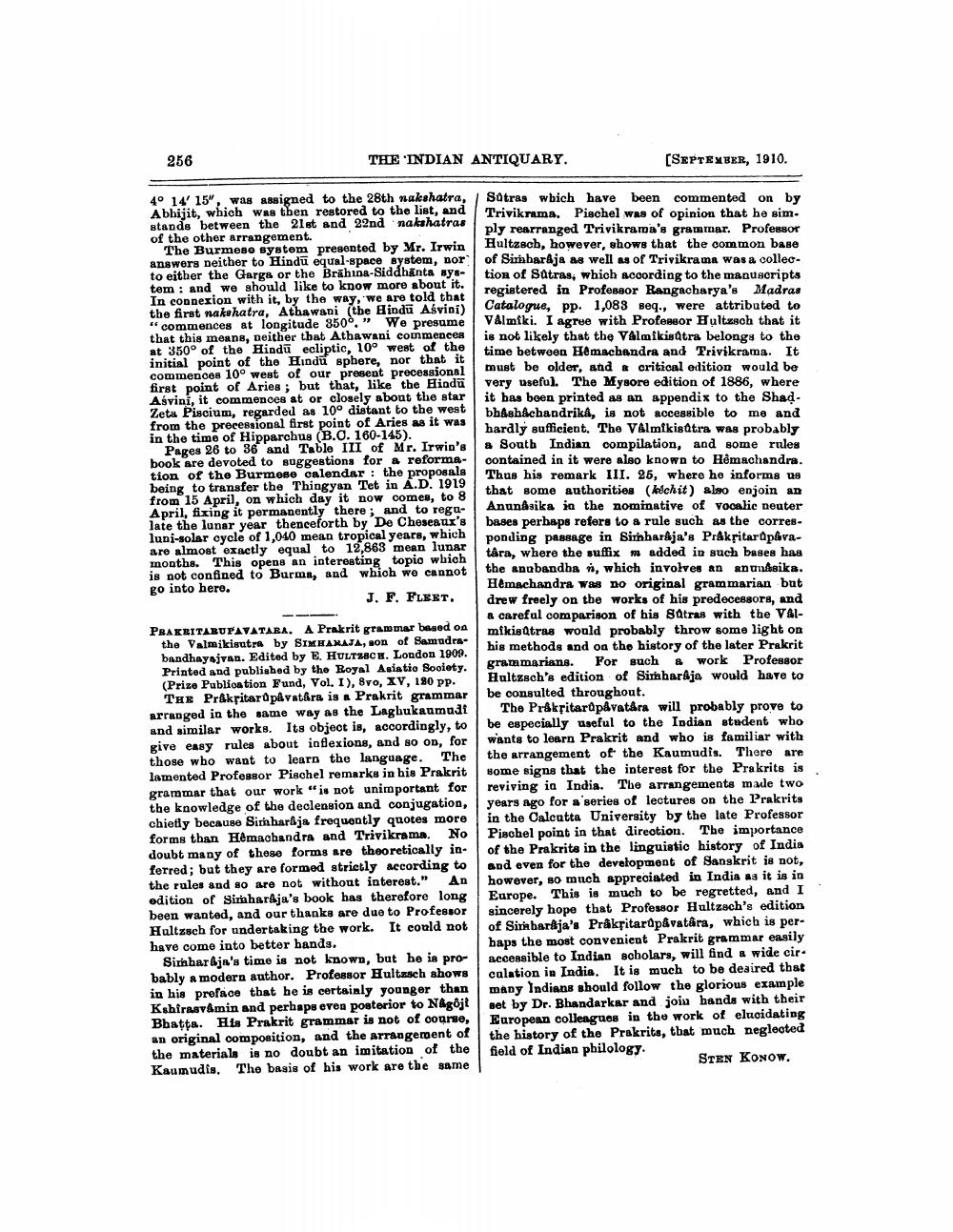________________
256
THE 'INDIAN ANTIQUARY.
[SEPTEMBER, 1910.
J. F. FLERT
40 1415"was assigned to the 28th nakshatra, Sotras wbich have been commented on by Abhijit, which was then restored to the list, and Trivikrama. Pischel was of opinion that he sim. stands between the 21st and 22nd nakshatras of the other arrangement.
ply rearranged Trivikrama's grammar. Professor The Burmese system presented by Mr. Irwin Hultzsch, however, shows that the common base answers neither to Hindu equal-space system, bor of SinnharAja as well as of Trivikrama was a collecto either the Garga or the Brihina-Siddhanta sys- tion of Satras which
tion of Sätras, which acoording to the manuscripts tem: and we should like to know more about it.
* registered in Professor Rangacharya's Madras In connexion with it, by the way, we are told that the first nakshatra, Athawani (the Hindu Asvini) Catalogue, pp. 1,083 Beq., were attributed to "commences at longitude 3500." We presume Valmiki. I agree with Professor Hultzsch that it that this means. neither that Athawani commences is not likely that the Valmikianthulant * at 350° of the Hindū ecliptic, 10° west of the
time between Hamachandra and Trivikrama. It initial point of the Hindu sphere, nor that it commences 10° west of our present processional
must be older, and a critical edition would be first point of Aries; but that, like the Hindu very useful. The Mysore edition of 1886, where AŚvini, it commences at or closely about the star it bas been printed as an appendix to the Shad. Zeta Piscium, regarded as 10o distant to the west
bhash&chandrika, is not accessible to me and from the precessional first point of Aries as it was
hardly sufficient. The Valmikisatra was probably in the time of Hipparchus (B.O. 160-145).
Pages 26 to 36 and Table III of Mr. Irwin's a South Indian compilation, and some rules book are devoted to suggestions for a reforma- contained in it were also known to Hêmachandra. tion of the Burmese calendar : the proposals
Thus his remark III. 25, where he informs us being to transfer the Thingyan Tet in A.D. 1919
that some authorities (ledchit) also enjoin an from 15 April, on which day it now comes, to 8 April, fixing it permanently there ; _and to regu
and to rega- Anungsika ia the nominative of vocalie neuter late the lunar year thenceforth by De Cheseaux's bases perbaps refers to a rule such as the corresluni-solar cycle of 1,040 mean tropical years, which
ponding passage in Sinharaja's Prakritarapavaare almost exactly equal to 12,863 mean lunar
tara, where the suffix madded in such bases has months. This opens an interesting topio wbich is not confined to Burma, and which we cannot
the anabandha ", which involves an anunsika. go into here.
Hémachandra was no original grammarian but drew freely on the works of his predecessors, and
a careful comparison of his Satras with the ValPRAKRITABUPAVATARA. A Prakrit grammar based on
mikisQtras would probably throw some light on the Valmikisutra by SIMHAXAJA, son of Samudrabandhayajvan. Edited by E. HULT38CH. London 1909.
his methods and on the history of the later Prakrit
grammarians. For such & work Professor (Prize Publioation Fund, Vol. 1), 8vo, XV, 180 pp.
Hultzsch's edition of Sirahardjo would have to The Pr&kitardpêvatára is a Prakrit grammar be consulted throughout.
in the same way as the Laghukaumudt | The Prákritard pêvatars will probably prove to and similar works. Its object is, accordingly, to be especially useful to the Indian student who give easy rules about inflexions, and so on, for wants to learn Prakrit and who is familiar with those who want to learn the language. The the arrangement of the Kaumudis. There are lamented Professor Pischel remarks in his Prakrit some signs that the interest for the Prakrits is grammar that our work is not unimportant for reviving in India. The arrangements made to the knowledge of the declension and conjugation, I years ago for a series of lectures on the Prakrits chietly because Simharaja frequently quotes more in the Calcutta University by the late Professor forms than Hamachandra and Trivikrama. No Piachel point in that direction. The importance doubt many of these forms are theoretically in- of the Prakrits in the linguistic history of India ferred; but they are formed strictly according to and even for the development of Sanskrit is not, the rules and so are not without interest." An
however, so much appreciated in India as it is in edition of Simharaja's book has therefore long Europe. This is much to be regretted, and I been wanted, and our thanks are due to Professor sincerely hope that Professor Hultzsch's edition Hultzsch for undertaking the work. It could not of Sirahardja's Prakritardpåvatara, which is perhave come into better bands.
baps the most convenient Prakrit grammar easily Simharfja's time is not known, but he is pro- accessible to Indian scholars, will find a wide cirbably a modern author. Professor Hultzsch shows calation in India. It is much to be deaired that in his preface that he is certainly younger than many Indians should follow the glorious example Kshirasv&min and perhaps even posterior to Ngôjt set by Dr. Bhandarker and join hands with their Bhatta. His Prakrit grammar is not of course, European colleagues in the work of elucidating an original composition, and the arrangement of the history of the Prakrits, that much neglected the materials is no doubt an imitation of the field of Indian philology, Kaumudis. The basis of his work are the same
STEN KONOW.




